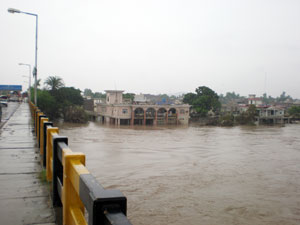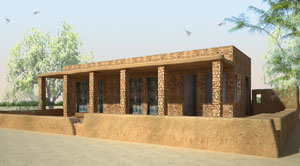The Other Side of the Spectrum
By Kayhan Feroze Qaiser | Opinion | Pakistan Floods 2010 | Viewpoint | Published 15 years ago
On August 3, 2010, I left Karachi to attend a wedding in Bangladesh. The summer holidays were then well underway, with students celebrating their freedom from the strictures of school regimens, and their parents busy formulating vacation plans. The summer, however, was not defined this way for long.
In the first week of the month, Pakistan was inundated by the worst floods in living memory, and within days millions had been displaced. I arrived in Pakistan a week later with images of the devastation caught on television screens across the globe playing like a reel in my mind.
Karachi looked and felt different: I was greeted not by billboards sporting the newest fashion outlets’ names and designs, but by advertisements encouraging me to donate and volunteer to help IDPs. Pakistan’s numerous news channels did not assault me with death tolls from the latest terrorist attacks, but provided me with important information about what problems relief camps faced, what needed to be done, and ongoing visual data to reinforce their message. My school companions too were in on the act. Instead of planning outings to movies and restaurants, they were planning trips to packaging centres to help pack food and clothing for flood affectees. It would not be an understatement to say that the entire country seemed to be united towards a common goal. The human cost of the floods was heart-rending. The Pakistani nation’s response, heartening.
 As soon as the floods hit, and in the absence of a structured government relief effort, foreign agencies and local aid organisations began mustering their resources on a war footing. There were the ubiquitous foreign aid groups: the UNHCR, UN World Food Programme, Oxfam, Save the Children, Red Cross, Médicins Sans Frontières, etc. Alongside, long-established local institutions like the Edhi Trust, Sungi, SIUT, LRBT and the Al-Shifa Trust, to name a few, sprang into action, and with them there were organisations that had been created in the wake of the 2005 earthquake, such as the Karachi Relief Trust (KRT) and HANDS, among many others. In addition, new groups also emerged, such as V Need U, ROPE, Ronaq-e-Qainat, The Express Helpline Trust, etc., etc., all working across the country with a single purpose: to help save lives by providing shelter, food and medical aid.
As soon as the floods hit, and in the absence of a structured government relief effort, foreign agencies and local aid organisations began mustering their resources on a war footing. There were the ubiquitous foreign aid groups: the UNHCR, UN World Food Programme, Oxfam, Save the Children, Red Cross, Médicins Sans Frontières, etc. Alongside, long-established local institutions like the Edhi Trust, Sungi, SIUT, LRBT and the Al-Shifa Trust, to name a few, sprang into action, and with them there were organisations that had been created in the wake of the 2005 earthquake, such as the Karachi Relief Trust (KRT) and HANDS, among many others. In addition, new groups also emerged, such as V Need U, ROPE, Ronaq-e-Qainat, The Express Helpline Trust, etc., etc., all working across the country with a single purpose: to help save lives by providing shelter, food and medical aid.
The vast scale of the disaster and the accompanying relief effort really dawned on me during my first trip to Thatta. Relief camps dotted the roadside all the way from Karachi along the highway to the town. They housed families who had lost everything but their fighting spirit. Some camps had been set up by NGOs, others — and perhaps the most organised ones — by the army, some by corporations, politicians, and political and religious groups, and even a few by individual philanthropists.
All the aid notwithstanding, by this time 20 million people had been displaced and UN supremo Ban Ki Moon was frequently quoted to have said that the floods had affected more people than the Indian Ocean tsunami, the Kashmir earthquake and the earthquake in Haiti combined. Certainly, the scale of the disaster was unprecedented. Equally true was the fact that no matter how well meaning, the relief efforts left a lot wanting. Some people were stranded without aid for weeks, and those who were rescued were often forced to live with dozens of other families in cramped schools or offices. Undeniable also was the fact that much of the devastation wrought and lives lost could have been prevented through flood warning systems and meteorological predictions.
But that is hindsight. The deluge was here and now. Yet, devastating though the fallout, equally staggering were some ignored, heartening facts. Apart from fatalities caused by water-borne diseases, drownings and accidents, the National Disaster Management Authority reported that 200 square kilometres of cultivated land had been destroyed by the floods and the economic cost to the exchequer ran into billions of rupees. Yet, it is interesting to note that even though 20 million mouths needed feeding, not one confirmed death was reported on account of a dearth of food. Government, international and private aid collectively seemed to manage to sustain the food needs of a tenth of the population for a period of over two months. Similarly, no deaths were reported as a result of inadequate shelter.
And while there were grave concerns about epidemics, timely action by the authorities and private institutions and individuals managed to avert what could have been a major health disaster. When a case of cholera was reported in Sukkur, for example, the Indus Hospital and Sina rounded up and sent a team of 24 doctors and paramedics to the area in under 48 hours. There they set up a treatment centre with an isolation unit and immediately began tending to those suffering from the disease in the town and those who began streaming in from surrounding regions. That the cholera was contained is particularly commendable given that the disease is quick to spread and can soon assume the proportions of an epidemic. Cholera in Haiti, for example, claimed 1,000 lives in just three weeks, according to officials there.
Relief efforts engendered some other unexpected benefits. Education on matters pertaining to hygiene, the importance of schooling and family planning took place on a large scale in relief camps across the country. The congregation of IDPs from remote rural areas in compact zones rather than in dispersed towns made them captive audiences to tips by aid organisations on an assortment of practices — many just the most basic ones — that could vastly improve the quality of their lives. For example, children and adults were taught not to leave behind puddles of water after bathing in the open, as mosquitoes thrive in such stagnating pools.
In one camp almost every child ate ghutka (a mild but addictive narcotic containing tobacco and beetle-nut that is popular in Pakistan and India because of its taste and ability to curb hunger, but which often results in oral cancer). Relief workers educated the children on the adverse affects of the drug, and within a week every child there had stopped consuming it.
Then there was the vocational training imparted. Many women were taught embroidery and handicrafts, so that while they were in the camps, and after they returned to their villages, they could gain some financial independence.
However, perhaps one of the greatest achievements during this period, was the introduction of a gravity-powered water filter known as Lifestraw. Designed by a Danish company, the device can provide microbiologically clean water for a family of five for three years — 18,000 litres of water to be precise. Many organisations such as UBL and KRT distributed these devices, which cost $25 per unit. The filters helped provide clean water for many families, but more importantly they impressed upon the people the need to sanitise water. And since children were explained the significance of the filters and taught to operate the units — easy enough for even young children to manoeuvre — chances are generation next will be more aware of the hazards of dirty water and the necessity to purify it than their parents and preceding generations.
 Pakistan spends 60% of its health budget on fighting water-borne diseases. Thus finding a way to prevent them may pave the way for marked improvements in the tackling of preventable ailments such as polio, diarrhoea, cholera and typhoid, among others. Families were given their Lifestraw when they returned to their villages, and groups are now attempting to put the filters on the market so that families can purchase them from local shops when they require them again.
Pakistan spends 60% of its health budget on fighting water-borne diseases. Thus finding a way to prevent them may pave the way for marked improvements in the tackling of preventable ailments such as polio, diarrhoea, cholera and typhoid, among others. Families were given their Lifestraw when they returned to their villages, and groups are now attempting to put the filters on the market so that families can purchase them from local shops when they require them again.
The flood waters began to recede about a month ago. Millions of people have returned to their villages and are attempting to rebuild their lives, and scores of others will be following suit. For many, whose homes and crops were swept away and who have no resources, that will be a difficult, if not impossible, undertaking. Once again, it is assorted relief organisations that are attempting to help. The KRT, for example, has already rebuilt one ‘model’ village in Sindh, and is aiming to build many more. These will include community health centres and schools. Their philosophy is one of sustainability. Not only do they want to build new homes for the affected, but they also want to build better lives. The envisaged homes will be able to withstand natural disasters even worse than these floods. The architects in the organisation have designed beautifully ethnic yet simple houses that can easily be constructed and extended, if so desired, with local materials. Buildings in rural villages are largely made from mud bricks, which results in structures that cannot withstand much strain. The KRT is now using and teaching simple modern construction techniques. For example, if bricks are made with a small percentage of cement and if a foundation of just two feet is present below a house, homes can be greatly fortified and sturdy.
Other groups are looking at other far-ranging sustainability schemes, including providing seeds to farmers and teaching them more cost-effective and successful methods of agriculture.
While donor fatigue is certainly beginning to set in — perfectly understandable in a cash-strapped nation beset by disasters, both natural and man-made — or if another calamity strikes and attention is diverted from the flood affectees, there is one thing this deluge has proved: Pakistan has the potential to overcome even the most formidable obstacles. It’s just a shame that it takes a disaster of such colossal proportions to bring this potential to the fore.


